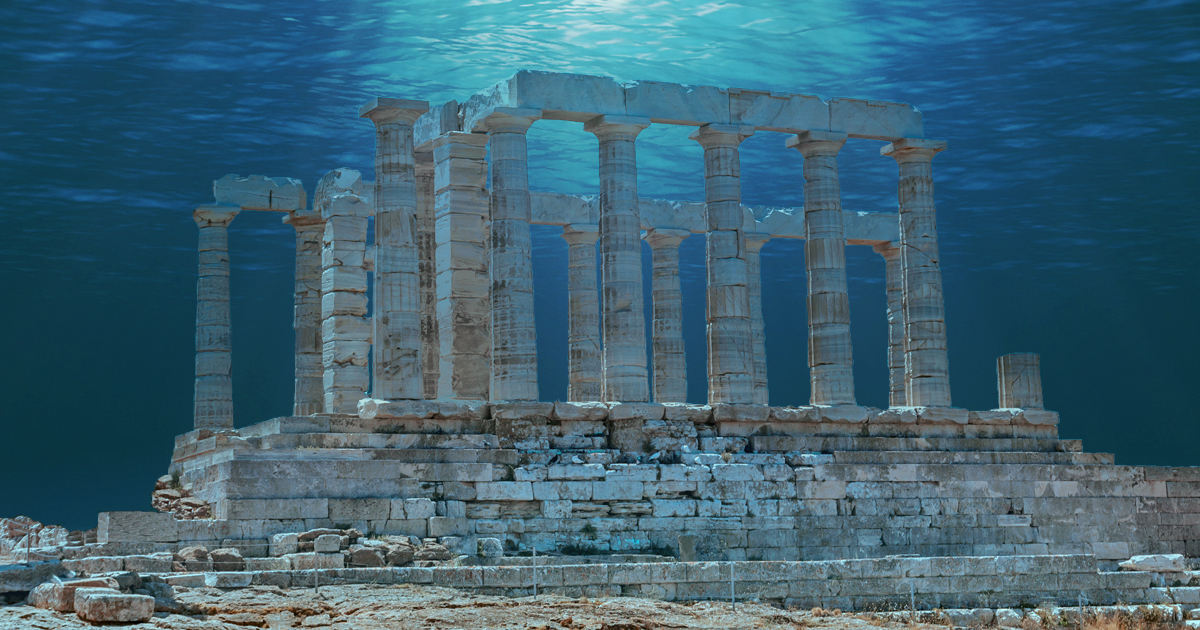Ancient authors such as the Greek historian Herodotus from the 5th century BC wrote about Heracleion, a great temple city in honor of Amun, the Egyptian god of the sun and the air. Amun was one of the most important gods during the New Kingdom from about 1570 to 1069 BC. The city, Thonis-Heracleion, which had become more legend than fact, was discovered in 2001 by Franck Goddio and the European Institute for Underwater Archaeology.
This is the city where Paris and Helen hid before the Trojan War and the city that hosted Herakles. Four hundred years later, Strabo, the Greek geographer and historian, wrote that Heracleion was located east of Canopus near the mouth of the River Nile. Some historians also believe Cleopatra III was installed as Pharaoh in this temple.
Heracleion was built in about the 8th century BC on sandy and hard clay soil that was already being permeated by water when the city was active. With the rise and fall of sea levels and earthquakes that frequent the area, Heracleion eventually slipped under the water where it rests now at about 1500 feet, according to Ancient Origins.
#Heracleion was an ancient #Egyptian city located near the Canopic Mouth of the #Nile, about 32 km northeast of Alexandria. Its ruins are located in Abu Qir Bay, currently 2.5 km off the coast, under 10 m of water. #AncientSiteSunday pic.twitter.com/d43tNqi5pj
— Digital Maps of the Ancient World (@DigitalMapsAW) September 22, 2019
While Goddio was aware of the myth of the underwater city, he wasn’t sure that it actually existed until he was searching for Napoleon’s warships from the Battle of the Nile in 1798 and found the remains of the base of the temple, according to Franck Goddio. The farther he moved around the area, the more artifacts and evidence of structures he found making his discovery arguably as important as the opening of King Tut’s tomb in 1922.
The Lost City of Heracleion. Once a bustling metropolis, this long-lost Egyptian city flooded, sank, and was forgotten — until archeologists rediscovered it. https://t.co/RR0nZOH2Yx #Heracleion
— Talking Pyramids💬 (@Bennu) August 20, 2019
While not as rich or opulent as the treasures in Tut’s tomb, the finds in Heracleion are so well preserved they offer a glimpse into the lives of Greeks and Egyptians during the time that Heracleion was a bustling major port in Egypt. Some of the incredible artifacts brought up from the sea include a sixteen foot tall red granite statue that some believe may be the Egyptian Pharaoh Ptolemy II as well as two sixteen foot tall red granite statues of Isis, a prominent Egyptian goddess with whom Cleopatra identified and the Egyptian god Hapi. Hundreds of amulets, small statues of gods, and sarcophagi of animal mummies that were sacrificed to Amun were brought up and preserved.
Divers Discover A Lost City That Had Been Underwater For 1,500 Years https://t.co/43UDWM7xyc #World #Heracleion via @sliptalking pic.twitter.com/n1wqxdVKN0
— Dano Edmund (@danoedmund) March 21, 2020
Goddio also found seven hundred anchors lined up as if in spaces in a parking lot, according to Archeology World, and sixty four ancient shipwrecks lying on the floor close to what was once the harbor in the Mediterranean Sea. Among the wrecked ships were piles of gold, golden jewelry, gold coins, bronze and lead weights, ceramic objects, and perfectly preserved steles, Egyptian columns inscribed with hieroglyphics.
Ancient underwater city #heracleion long hidden suddenly revealed… https://t.co/noOjtgQVeM pic.twitter.com/o25Bj74lGw
— Christian Furr (@Pientello) October 15, 2017
One particular stele recorded ships that came into port and the taxes and duties they owed and paid. Canals were built into the city, making it almost Venice-like, and residences were built on areas away from the center of town as if they were in a suburb. Surprisingly, many of the objects found were of Greek origin with Egyptian names and vice-versa, showing how closely the two counties traded together. Even an age-old mystery concerning the cities of Thonis and Heracleion was solved when Goddio realized from the hieroglyphics that Thonis was the Egyptian name and Heracleion was the Greek name for the same city.
The ancient city was one of the most important ports in Egypt until Alexander the Great conquered Egypt in 332 BC and went on to found Alexandria about twenty miles away, which became the largest and most prosperous city at the time. With its world famous library, it was considered an important center of learning attracting such scholars as Archimedes, Euclid, and Hero according to Ancient History Encyclopedia. As Alexandria grew in power and status, Heracleion waned and almost became an afterthought.
Related Article: The 4 Most Intriguing Lost Underwater Cities of the World
Most of the Thonis-Heracleion artifacts are in such good shape because for over two thousand years the silt on the bottom of the sea protected them from deterioration. Goddio and his team have only uncovered five percent of the city which he claims is three times the size of Pompeii and predicts that exciting discoveries will be made for years to come.
